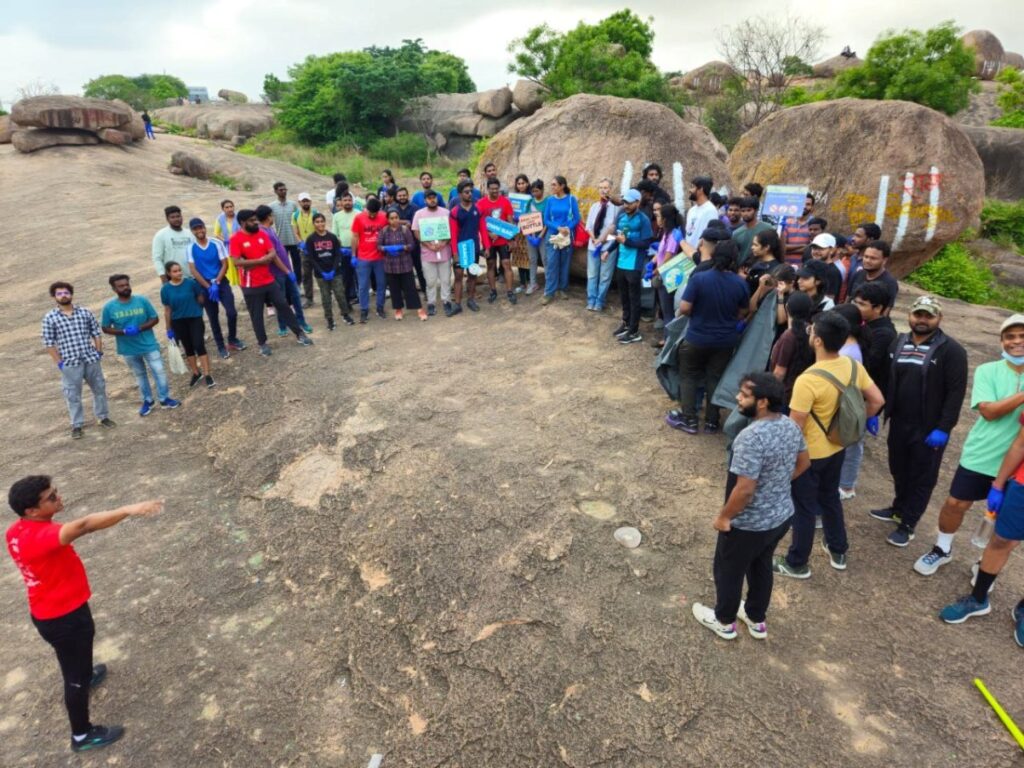
Hyderabad: About 70 people turned up in the early morning on Sunday, June 9, to clean up the trash from the ancient Khajaguda rocks in the city. The drive was led by a handful of civil society groups at the site, which has become a victim of government and citizen apathy as several visitors there simply throw garbage and litter the place without any consequences. The Khajaguda rocks has also been subject to several encroachments over the last decade, and still has not been fenced by the HMDA.
“About 65-70 people had come today morning for the clean up. It started from 630 a.m. and we had finished by about 8 a.m.,” said Sangeeta Varma from the Society to Save Rocks. The Khajaguda Rocks clean up drive was also jointly done by Waste Project, EastMan group, Society to Save Rocks, High Flyers (which works on soft skills for underprivileged students) and members of the Hyderabad Cycling Club were also present.
What was disconcerting for Sangeeta was that in spite of filling up 74 bags of trash, there was a lot more to be done. “The 74 bags were maybe 1% of the trash. There were water bottles, soft drink bottles, sachets, cigarette lighters, and what not. It was 1.5 hours of utter frustration, as there were small shards from broken bottles. We had to remove trash from crevices of rocks as well. There was a group celebrating a birthday, and even though they were watching us, they broke their bottles too,” she said.
More recently in March, taking cognizance of encroachments at the historic Khajaguda rocks, the Hyderabad Metropolitan Development Authority (HMDA) demolished illegally constructed gates within the premises. HMDA officials also retained possession of the heritage site, which has been besieged with encroachments over the last two years. In the last three weeks, two illegal temple sanctums and gates were built within the premises.

Two new unauthorised sanctums were built at the historic Khajaguda rocks earlier this year. The site has been facing severe threats of encroachments over the last few years, which include drilling and destruction of ancient rock structures by different parties. Activists who are involved in protecting the site believe that it is being done across the 270 acre site to appropriate it in the name of religion.
“There is no policeman, no security. One group of people also was using a police siren. Hopefully people will understand that they should not throw trash,” added Sangeeta.
HMDA was supposed take control of Khajaguda rocks
The Khajaguda rock site is an ancient site and important part of Hyderabad’s terrain. It was earlier a protected side and was in the state government’s list of protected sites. It cannot be altered, and any work there has to be done by seeking permission from the HMDA. The rock formations here reportedly date back to millions of years ago.
“They were supposed to fence the entire Khajaguda Hills, and the contractor was also there. The HMDA has not done it yet, and the security who was there earlier has also been removed. We have also started asking the government to put the Khajaguda Hills back on the protected list of monuments,” said Sangeetha. She also thanked the Narsingi municipality for sending the truck to collect the garbage bags.
Khajaguda rocks history
Fakhruddin Gutta, popularly known as Khajaguda Hills, is a protected heritage site in Hyderabad. It is immensely loved and visited by trekkers, rock climbers, walkers, and others. However, for more than a decade, the place has been witnessing destruction due to encroachment. The site with rocks dating to several million years is located in Nanakramguda in Hyderabad. It is just a 20-minute drive from the Amazon Hyderabad campus and the Indian School of Business (ISB) in Gachibowli. Khajaguda rocks also provide a green lung space amidst the hectic, concrete-filled IT corridor.
It is also the location of the Hyderabad Climbing Championship that is gaining recognition across the country. The rock formations at Khajaguda, dating to several million years, are unique in several ways. Several caves systems in Telangana are not formed by the movement of water, but by the gradual weathering and breaking away of granite in hillocks.
